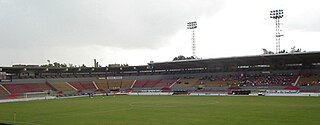
Guadalajara is a metropolis in western Mexico and the capital of the state of Jalisco. The city has a population of 1,460,148, while the Guadalajara metropolitan area has a population of 5,002,466, making it the second-largest metropolitan area in the country. Guadalajara has the second highest population density in Mexico, with over 10,361 people per square kilometre. Guadalajara is an international center of business, finance, arts, and culture, as well as the economic center of the Bajío region, one of the most productive and developed regions in Latin America.

Ixtlahuacán del Rio is a town and municipality in the center of the Mexican state of Jalisco, a little less than 50 kilometers from state capital Guadalajara. It stands at 1,655 meters above sea level; the climate is semi-arid, with a mild winter and an average annual temperature of 19 degrees Celsius.

The Estadio 3 de Marzo, is situated in Zapopan, Jalisco, México, district that forms part of the Guadalajara Metropolitan Area; it is the ground of Tecos; which plays in the Liga Premier de México, also, since 2020 it has been the ground of Halcones de Zapopan and Jaguares de Jalisco; who plays at Liga de Balompié Mexicano. It has a capacity of 18,779 and was constructed inside the campus of the Universidad Autónoma de Guadalajara.

Zapopan is a city and municipality located in the Mexican state of Jalisco. Part of the Guadalajara Metropolitan Area, the population of Zapopan city proper makes it the second largest city in the state, very close behind the population of Guadalajara proper. It is best known as being the home of the Virgin of Zapopan, an image of the Virgin Mary which was made in the 16th century. This image has been credited with a number of miracles and has been recognized by popes and even visited by Pope John Paul II. The municipality is also the home of the Centro Cultural Universitario, which contains one of the most important concert venues in Latin America and is the home of the new stadium for the C.D. Guadalajara.

Talpa de Allende is a city and municipality in Jalisco, Mexico. Surrounded by pine-covered mountains, Talpa de Allende is a silver mining town founded by the Spanish in 1599. The name "Allende" is in honor of General Ignacio Allende.

Jalisco, officially the Free and Sovereign State of Jalisco is one of the 32 states which comprise the Federal Entities of Mexico. It is located in Western Mexico and is bordered by six states which are Nayarit, Zacatecas, Aguascalientes, Guanajuato, Michoacán, and Colima. Jalisco is divided into 125 municipalities, and its capital city is Guadalajara.

Mazamitla is a town and municipality of the Mexican state of Jalisco. It is located 124 km south of Guadalajara in the Southeast Region and is a popular resort destination for travelers from Guadalajara and near urban centers. Its name comes from the Nahuatl and means "place where arrows are made to hunt deers"; its area is 177.18 km2. According to Count II Population and Housing, the municipality has 11671 inhabitants who are devoted mainly to the tertiary sector. For its natural environment it is considered by the federal Secretariat of Tourism as a Pueblo Mágico.

Tala is a town and a municipality in the state of Jalisco, Mexico. It is a small town that has grown over the years. Some major towns in the municipality are Tala, El Refugio, San Isidro Mazatepec, Cuisillos, and Ahuisculco.

Tecolotlán is a town and municipality, in Jalisco in central-western Mexico. The municipality covers an area of 795.55 km².
Sierra de Quila, officially the Sierra de Quila Flora and Fauna Protection Area, is a Mexican Flora and Fauna Protection Area in the state of Jalisco, Mexico, managed by the National Commission of Natural Protected Areas (CONANP), and located within six municipalities: San Martín de Hidalgo, Tecolotlán, Cocula, Atengo, Tenamaxtlán, and Ameca. Having an area of 15,193 hectares and established as a wildlife protection zone on August 4, 1982, Sierra de Quila is the most recent and smaller of the two wildlife protection areas in the state, the other being La Primavera.

La Resistencia, also known as Cárteles Unidos is a Mexican criminal enforcer squad composed of well trained gunmen from the Sinaloa Cartel, Gulf Cartel and Knights Templar Cartel dedicated to killing or expelling the Los Zetas Cartel operatives from the states of Michoacán and Jalisco.
The 2012–13 UANL season is the 66th professional season of Mexico's top-flight football league. The season is split into two tournaments—the Torneo Apertura and the Torneo Clausura—each with identical formats and each contested by the same eighteen teams. UANL began their season on July 20, 2012 against Chiapas, UANL play their home games on Saturdays at 7:00 pm local time.
Same-sex marriage is legal in the Mexican state of Jalisco, following a unanimous ruling on 26 January 2016 by the Supreme Court of Justice of the Nation which held that the state's ban on same-sex marriage violated Articles 1 and 4 of the Constitution of Mexico. However, some municipalities refused to marry same-sex couples until being ordered by Congress to do so on 12 May 2016.

Rubén Oseguera González, commonly referred to by his alias El Menchito, is a U.S.-born Mexican suspected drug lord and former high-ranking member of the Jalisco New Generation Cartel (CJNG), a criminal group based in Jalisco. He is the son of Nemesio Oseguera Cervantes, Mexico's most-wanted man. Under his father, he allegedly worked as the CJNG's second-in-command and managed international drug trafficking operations. Oseguera González was first arrested in January 2014 in Jalisco, but was released in October for lack of evidence and re-arrested immediately as he walked out of prison. He was then released again in December after a judge considered the evidence against him as insufficient. In June 2015, Oseguera González was arrested again, released a month later, and re-arrested as his release order was made official. His legal case has highlighted the growing tensions and deficiencies between prosecutors and judges in Mexico.

Julio Alberto Castillo Rodríguez, commonly referred to by his alias Ojo de Vidrio, is a Mexican suspected drug lord and former high-ranking leader of the Jalisco New Generation Cartel (CJNG), a criminal group based in Jalisco. He is the son-in-law of Nemesio Oseguera Cervantes, the leader of the CJNG and one of Mexico's most-wanted drug lords. He was reportedly responsible for managing money laundering schemes for the CJNG.

Érick Valencia Salazar, commonly referred to by his alias El 85, is a Mexican suspected drug lord and high ranking leader in the Nueva Plaza Cartel. He previously served as a high-ranking leader of the Jalisco New Generation Cartel (CJNG), a criminal group based in Jalisco. The Mexican Army suspects he was responsible for supervising the CJNG's cocaine and ephedrine delivery shipments from Colombia and China to Mexico, and for coordinating attacks against rival groups like La Resistencia and Los Zetas in the 2010s. Before leading the CJNG, El 85 reportedly held a leadership role within the Milenio Cartel, the predecessor group where the CJNG originated from. When several of his superiors were arrested and/or killed, El 85 and several others from the Milenio Cartel reportedly formed the CJNG.

On 6 April 2015, a convoy of the Jalisco State Police was ambushed by suspected members of the Jalisco New Generation Cartel (CJNG), a criminal group based in Jalisco. The attack occurred in a mountain road in San Sebastián del Oeste, Jalisco. Fifteen policemen were killed and five were wounded; no CJNG casualties were confirmed. According to police reports, as the police convoy reached a part of the road surrounded by mountains, the CJNG opened fire at the police units from the sides using high-caliber rifles, grenade launchers, and explosives with gasoline. The element of surprise prevented the police from repelling the aggression. The CJNG members burned several vehicles along the highway to halt reinforcements. The attack lasted roughly 30 minutes. When government reinforcements reached the scene, the CJNG gunmen had left.

On 1 May 2015, the Jalisco New Generation Cartel (CJNG) carried out a series of attacks in Jalisco, Mexico, and four adjacent states to prevent the capture of Nemesio Oseguera Cervantes, their suspected leader. The operation began early that morning in Villa Purificación, where four Mexican Air Force and Federal Police (PF) helicopters spotted a CJNG convoy protecting El Mencho. As one of the helicopters flew over the convoy, the CJNG members shot it down using rocket-propelled grenade (RPG) launchers. Nine law enforcement officers died as a result of the attack, and multiple others were wounded. This was the first incident in the Mexican Drug War in which organized crime groups shot down an aircraft.

Martín Arzola Ortega, commonly referred to by his alias "El 53", was a Mexican convicted drug lord and former high-ranking leader of the Jalisco New Generation Cartel (CJNG), a criminal group based in Jalisco. He worked under Nemesio Oseguera Cervantes, the alleged top leader of the CJNG. Arzola Ortega began his criminal career in 1998 as a cargo truck thief and eventually joined the Milenio Cartel, the predecessor group of the CJNG. After several of his bosses were arrested and/or killed, he founded the CJNG with other defectors in the 2010s.
The Jalisco team, formerly called Atlético Jalisco, was a Mexican professional football team based in Guadalajara, Jalisco, Mexico that played in Liga de Balompié Mexicano.
















